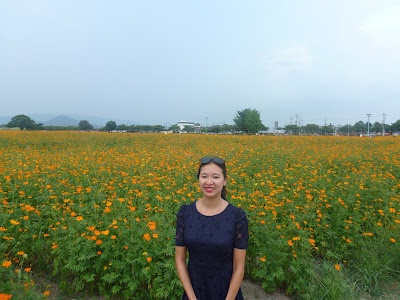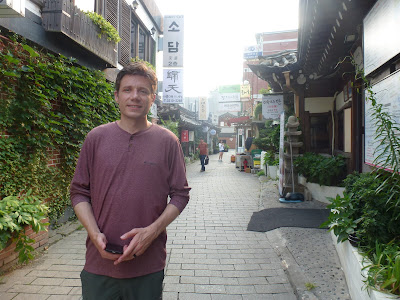Seoraksan is a beautiful national park that is about a 3 hour bus ride to the east of Seoul (see below for Marc's info on the bus ride). It is the most famous/popular national park in the country and we thought it would be a great opportunity to see the more natural side of Korea.
We ended up staying near Sokcho, a small city that is right outside of the park. The accommodations were pretty kitschy and basic, but mostly we needed A/C and the internet. Ah, many a night with convenience store ramen in this hotel room.
 |
| Stylish green slippers. |
The little town that we were staying in appeared to be dying economically because for every open hotel we saw, there were 3 overgrown, derelict, mostly deserted, and creepy hotels.
 |
| Way too happy to be standing in front of an abandoned hotel, haha. |
The park was beautiful, with many stone bridges crossing the rivers, and well designated paths and trails. There were mostly middle aged Korean couples or families with small children, all tricked out with the latest brightly colored hiking clothes and walking sticks.
 |
| So picturesque! |
The first day we decided to do an "advanced" climb to the top of Ulsanbawi Rock, which is 3.8 km / 2.4 miles, 876 m / 2800 feet up, and took about 2-3 hours one way. By the end it was just a long staircase anchored to the cliff. Oof!
At the top, there is one guy with a little shelter set up where he is selling Korean ice tea for 5000 KRW per cup. Which means that he schleps all his materials (and ice) up to the top of that mountain by foot every single day, since there isn’t any other way up!
That same day we decided to take on another hike to the Biryong Falls hike to see the waterfalls (3 km / 1.9 miles) with a small waterfall of 16 m / 52 feet.
 |
| Not the most powerful of waterfalls, but pretty nevertheless. |
The next day we were pretty worn out from the previous hikes, so we took the leisurely Bisoeondae section hike which has more gentle slopes (3km/1.9miles). Both hiking days were very hot (95⁰F / 35⁰C) with high humidity, so while we were melting, we were surprised to see so many people carrying large backpacks full of camping gear.
We took the cable car up to the top of one of the Gwongeumseong Fortress Peak and hiked to the tippity top of a very precarious viewpoint. Again, I was surprised that so many people (particularly older people and young kids) were basically free fall rock climbing some of these small cliffs to get to the top.
Gyeongju: Aug 7-9
Next, we took a bus back to Seoul and then a high-speed train to Gyeongju, which is a southeastern coastal city that was once the ancient capital of Silla. We stay in a guesthouse that is run by a lady that is a total mom. She is super helpful, and wanted to walk us to a nearby Vietnamese/Korean restaurant. She actually ends up walking in, sitting down, and choosing food for us! I guess she really wanted to make sure we ate, haha. The food appears to be hot pot, so we put all the veggies into the pot. The waitress comes by, horrified. It's a Vietnamese hot pot where you are supposed to boil the meat, but keep the veggies fresh to put in a spring roll. Doh!
 |
| Cooking fail. |
To start off our first full day in Gyeongju, we head to a local market which almost looks like a basement alleyway with tons of middle aged Korean women selling food from small kitchens that line both sides of the walkway. It looks a bit dodgy, but the food was delicious and cheap. We ended up going back more than a few times.
 |
| These are definitely some hard working ladies. |
We take the bus to Bulguksa Temple which is a bit outside of the downtown. It was blisteringly hot that day, so we envied the people at a water park that we passed (I regret that we didn't go!).
Although we are a bit "templed out" after seeing so many in Seoul, we decide to head to the Seokguram Grotto, which houses a stone Buddha from the 700s (sorry, no pics allowed inside)!
 |
| Colorful lanterns outside the temple. |
Next, we head to the downtown area of Gyeongju where there are beautiful flower fields and ancient ruins.
 |
| Field of lotus. |
 |
| Field of "rape" flowers. Oh what a name. |
 |
| The two in the forefront are ancient burial mounds. Don't be fooled by the picture, they can be several stories high. |
 |
| Cheomseongdae, the oldest astronomical observatory in East Asia. |
Our last day in Gyeongju, we decide to visit a traditional Korean folk village that was founded in the 1400s called Yangong.
Later that evening, we take the guesthouse bikes for a spin downtown to visit the Donggung Palace and the serene Woliji Pond.
Seoul: Aug 10-11
Rounding out our time in Korea, we take the high speed train back from Gyeongju to Seoul. We stayed in a traditional Korean hanok where you sleep on comfy mats on the floor.
 |
| Our traditional hanok home stay. |
We set out to see the Yeouido-Dong area, which is the south side of the Namhan river that runs through the middle of Seoul. There was a nice waterfront area where many young people were hanging out and having picnics.
 |
| Is it "Blue steel" or "Sparrow face"? |
The next day, we went to the Alive! Museum in Insadong, a cool museum where you can become part of the paintings with optical illusions.
We finished our time in Seoul by going to the Honkik University area where all the young kids hang out. It has a cool walking street with tons of clothing and knick nack shops, as well as bars and night clubs.
Next up, Beijing!
We finished our time in Seoul by going to the Honkik University area where all the young kids hang out. It has a cool walking street with tons of clothing and knick nack shops, as well as bars and night clubs.
Next up, Beijing!


















































